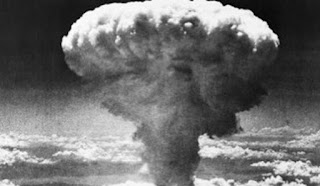As one speaks of the bombings of Hiroshima and Nagasaki this August, let's pay heed to an event, unspoken- a crucial misunderstanding of the very nature of the atomic bombing.
 This dates back to the meetings of the "Target Committee" in the spring of 1945, deliberating on the possible target cities, high in strategic value.- Hiroshima, Yokohama, and Kyoto, amongst others.
This dates back to the meetings of the "Target Committee" in the spring of 1945, deliberating on the possible target cities, high in strategic value.- Hiroshima, Yokohama, and Kyoto, amongst others.A major rail connects between Osaka and Tokyo, several wars produce factories, an aircraft engine factory, and an urban population made Kyoto of importance.
With the second meeting at Oppenheimer’s office, Kyoto increased in importance. Kyoto stood to be the first, with target maps depicting the city with a circle of impact, thus the seriousness of the plan.
On May 15, 1945, a directive was issued to the US Army Air Forces requesting that Hiroshima, Kyoto, and Niigata be put on a list of “Reserved Areas” not to be bombed so that they could be preserved as atomic bombing targets.
 On 30th May, Lieutenant General, Leslie Groves met the US secretary of war, Henry Stimson, to
On 30th May, Lieutenant General, Leslie Groves met the US secretary of war, Henry Stimson, to discuss the matter. Kyoto is the cultural center of Japan, the former capital of the country,
Stimson told him bluntly: “I don’t want Kyoto bombed.”
Why did Stimson insist on sparing Kyoto?
Was it his personal connection to the city?
Was he trying to assuage guilt? Did he intend to preserve better postwar relations with the Japanese? There are competing interpretations.
Even Until July 25th, 15 days prior to the event, the target cities weren't finalized.
From excerpts of Stimson's Diary, we understand that at the Postdam Conference, Stimson reasoned out to President Truman, his stand of eliminating Kyoto as a target.
"If elimination was not done, the bitterness which would be caused by such a wanton act might make it impossible during the long post-war period to reconcile the Japanese to us in that area rather than to the Russians."
Stimson left the meeting thinking Truman completely understood the matter,
Thus, the final target order rolled out- Hiroshima, Kokura, Niigata, and Nagasaki!
Having said that, where did the misconception lie?
In Truman's diary entry of the same meeting.
 "I have told the Sec. of War, Mr. Stimson, to use it so that military objectives and soldiers and sailors
"I have told the Sec. of War, Mr. Stimson, to use it so that military objectives and soldiers and sailors are the target and not women and children. Even if the Japs are savages, ruthless, merciless, and fanatic, we as the leader of the world for the common welfare cannot drop that terrible bomb on the old capital or the new."
This passage reflects an incredible misconception.
Truman appears, here, to believe that the target cities were “ purely military” targets, and that “soldiers and sailors” would be killed, “not women and children.”
Every city on that list, besides having military connections, was also primarily inhabited by civilians- children and women. Stimson was probably trying to say that the cultural value of Kyoto outweighed its value as a strategic target. The lack of a large military base in Kyoto made it more of a “civilian” target in his mind than Hiroshima or Nagasaki. Truman seems to have interpreted the discussion as a contrast between a “civilian” target and a “military” one.
Statistics make revelations of the school children killed, something that underscores that these “purely military” targets were a little less than “pure.”
 Did Truman sign off an order to wipe out children, believing they are exclusively destroying military
Did Truman sign off an order to wipe out children, believing they are exclusively destroying militarytargets?
Laying premise on the earlier spoken diary entry, going away and misconceiving the discussions about Kyoto, led to a very incorrect understanding of what the atomic bomb targets really were.